ACCG950: Comparative Analysis of Sustainability and Integrated Reports
VerifiedAdded on 2023/06/10
|10
|2279
|483
Report
AI Summary
This report provides a comprehensive analysis of the sustainability reports of Orica Limited and Sandfire Resources NL, two Australian companies that adhere to the Global Reporting Initiative (GRI) guidelines. The report begins by outlining the purposes of providing GRI reports for both companies, highlighting Orica's focus on stakeholder communication and Sandfire's commitment to safety, environmental management, and transparency. It then identifies and examines the key stakeholders for each company, including employees, customers, shareholders, and local communities, explaining their interests in the reports. A detailed comparison of the similarities and differences between the reports follows, noting the companies' adherence to GRI principles while highlighting differences in reporting practices, such as the inclusion of a sustainability scorecard. The report critically evaluates the quality of information, consistency with GRI standards, and how well the reports meet stakeholder needs. The analysis concludes that both companies effectively utilize GRI standards to meet stakeholder requirements, emphasizing the importance of sustainability reporting in today's business environment.
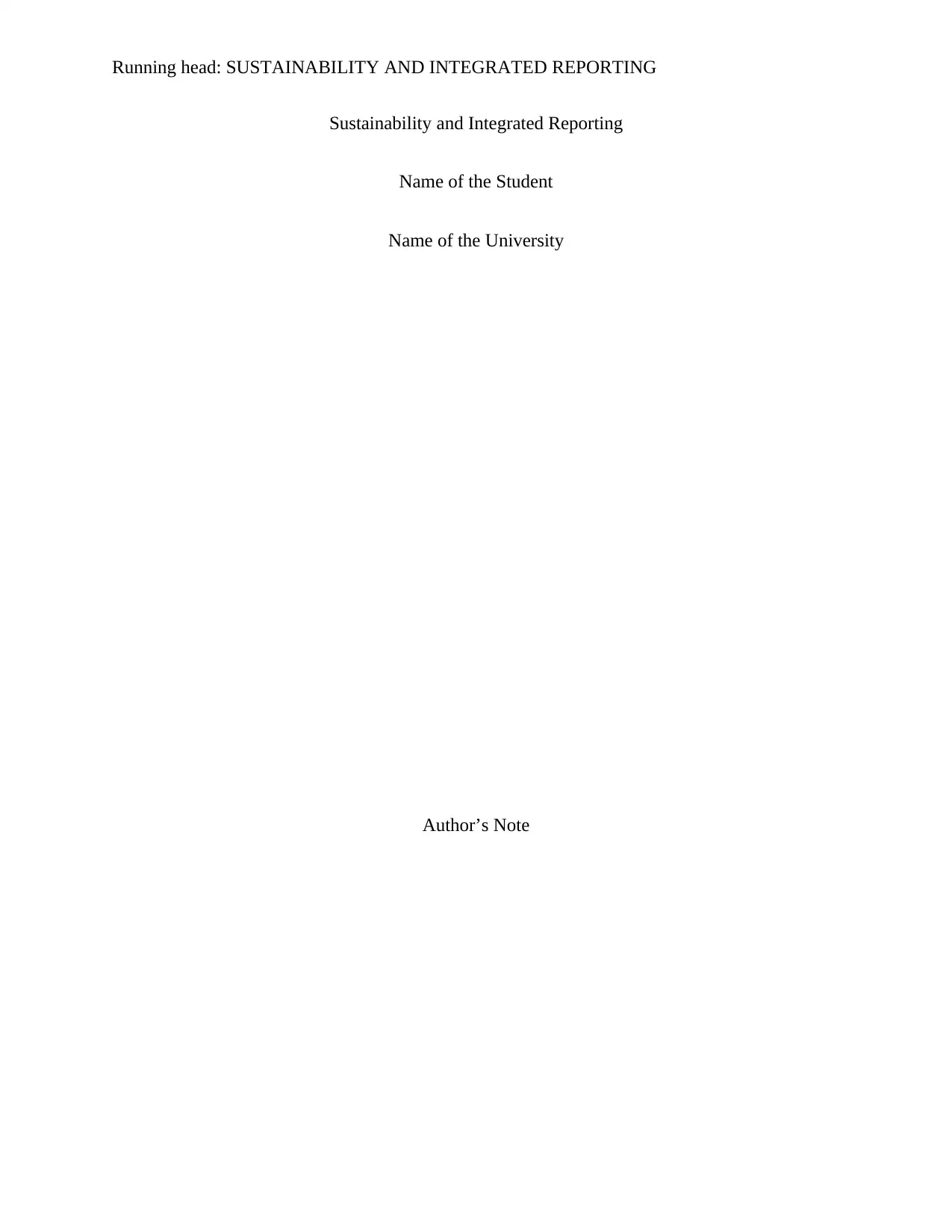
Running head: SUSTAINABILITY AND INTEGRATED REPORTING
Sustainability and Integrated Reporting
Name of the Student
Name of the University
Author’s Note
Sustainability and Integrated Reporting
Name of the Student
Name of the University
Author’s Note
Paraphrase This Document
Need a fresh take? Get an instant paraphrase of this document with our AI Paraphraser
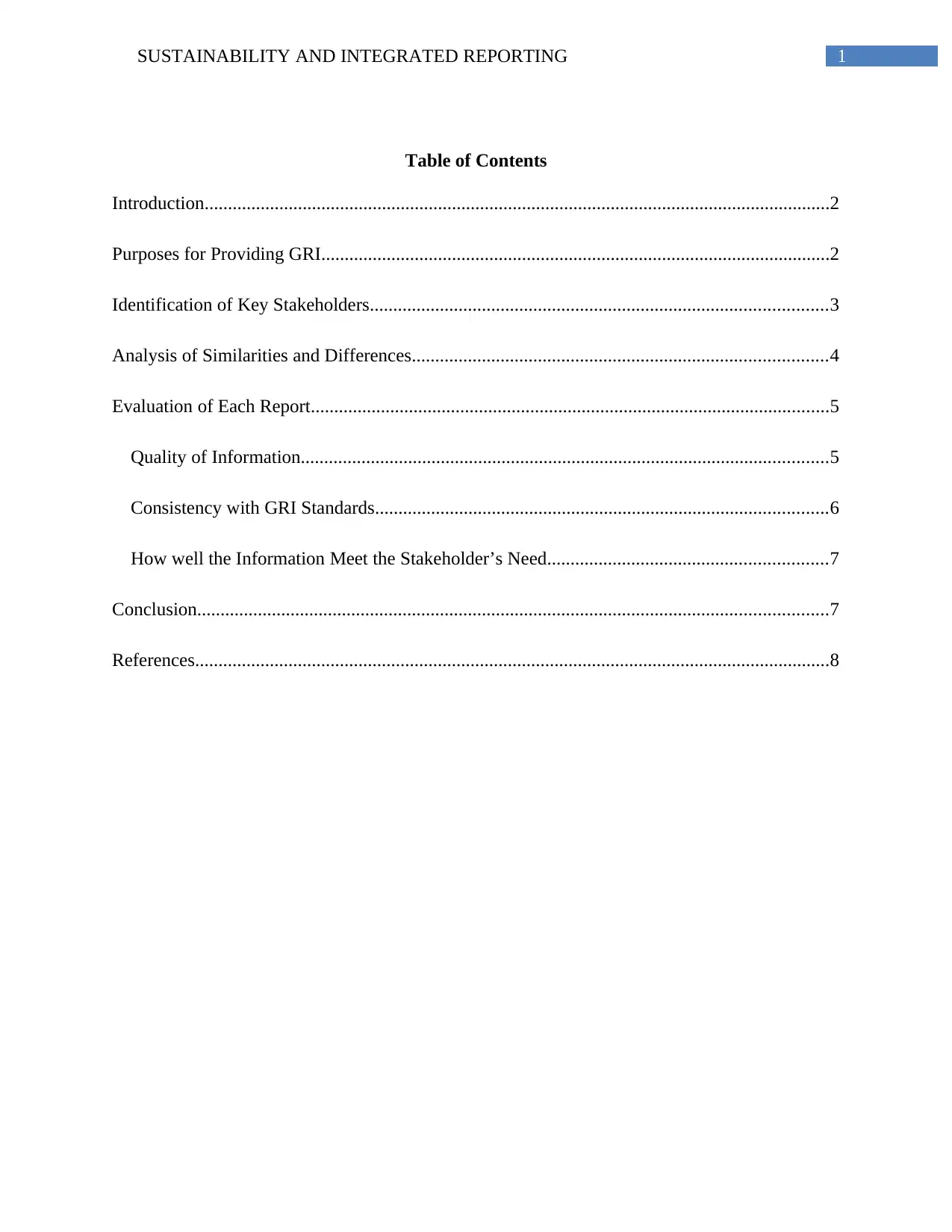
1SUSTAINABILITY AND INTEGRATED REPORTING
Table of Contents
Introduction......................................................................................................................................2
Purposes for Providing GRI.............................................................................................................2
Identification of Key Stakeholders..................................................................................................3
Analysis of Similarities and Differences.........................................................................................4
Evaluation of Each Report...............................................................................................................5
Quality of Information.................................................................................................................5
Consistency with GRI Standards.................................................................................................6
How well the Information Meet the Stakeholder’s Need............................................................7
Conclusion.......................................................................................................................................7
References........................................................................................................................................8
Table of Contents
Introduction......................................................................................................................................2
Purposes for Providing GRI.............................................................................................................2
Identification of Key Stakeholders..................................................................................................3
Analysis of Similarities and Differences.........................................................................................4
Evaluation of Each Report...............................................................................................................5
Quality of Information.................................................................................................................5
Consistency with GRI Standards.................................................................................................6
How well the Information Meet the Stakeholder’s Need............................................................7
Conclusion.......................................................................................................................................7
References........................................................................................................................................8
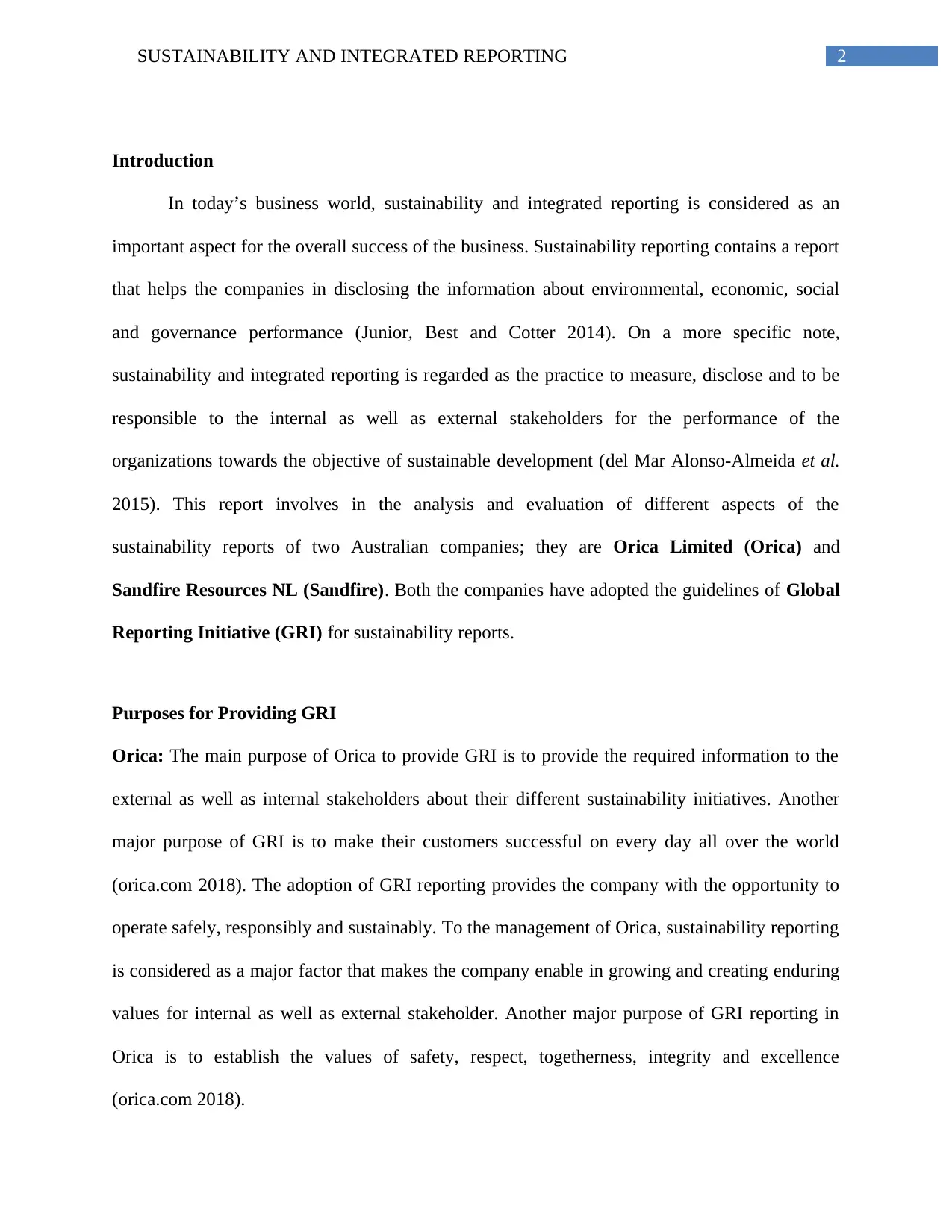
2SUSTAINABILITY AND INTEGRATED REPORTING
Introduction
In today’s business world, sustainability and integrated reporting is considered as an
important aspect for the overall success of the business. Sustainability reporting contains a report
that helps the companies in disclosing the information about environmental, economic, social
and governance performance (Junior, Best and Cotter 2014). On a more specific note,
sustainability and integrated reporting is regarded as the practice to measure, disclose and to be
responsible to the internal as well as external stakeholders for the performance of the
organizations towards the objective of sustainable development (del Mar Alonso-Almeida et al.
2015). This report involves in the analysis and evaluation of different aspects of the
sustainability reports of two Australian companies; they are Orica Limited (Orica) and
Sandfire Resources NL (Sandfire). Both the companies have adopted the guidelines of Global
Reporting Initiative (GRI) for sustainability reports.
Purposes for Providing GRI
Orica: The main purpose of Orica to provide GRI is to provide the required information to the
external as well as internal stakeholders about their different sustainability initiatives. Another
major purpose of GRI is to make their customers successful on every day all over the world
(orica.com 2018). The adoption of GRI reporting provides the company with the opportunity to
operate safely, responsibly and sustainably. To the management of Orica, sustainability reporting
is considered as a major factor that makes the company enable in growing and creating enduring
values for internal as well as external stakeholder. Another major purpose of GRI reporting in
Orica is to establish the values of safety, respect, togetherness, integrity and excellence
(orica.com 2018).
Introduction
In today’s business world, sustainability and integrated reporting is considered as an
important aspect for the overall success of the business. Sustainability reporting contains a report
that helps the companies in disclosing the information about environmental, economic, social
and governance performance (Junior, Best and Cotter 2014). On a more specific note,
sustainability and integrated reporting is regarded as the practice to measure, disclose and to be
responsible to the internal as well as external stakeholders for the performance of the
organizations towards the objective of sustainable development (del Mar Alonso-Almeida et al.
2015). This report involves in the analysis and evaluation of different aspects of the
sustainability reports of two Australian companies; they are Orica Limited (Orica) and
Sandfire Resources NL (Sandfire). Both the companies have adopted the guidelines of Global
Reporting Initiative (GRI) for sustainability reports.
Purposes for Providing GRI
Orica: The main purpose of Orica to provide GRI is to provide the required information to the
external as well as internal stakeholders about their different sustainability initiatives. Another
major purpose of GRI is to make their customers successful on every day all over the world
(orica.com 2018). The adoption of GRI reporting provides the company with the opportunity to
operate safely, responsibly and sustainably. To the management of Orica, sustainability reporting
is considered as a major factor that makes the company enable in growing and creating enduring
values for internal as well as external stakeholder. Another major purpose of GRI reporting in
Orica is to establish the values of safety, respect, togetherness, integrity and excellence
(orica.com 2018).
⊘ This is a preview!⊘
Do you want full access?
Subscribe today to unlock all pages.

Trusted by 1+ million students worldwide
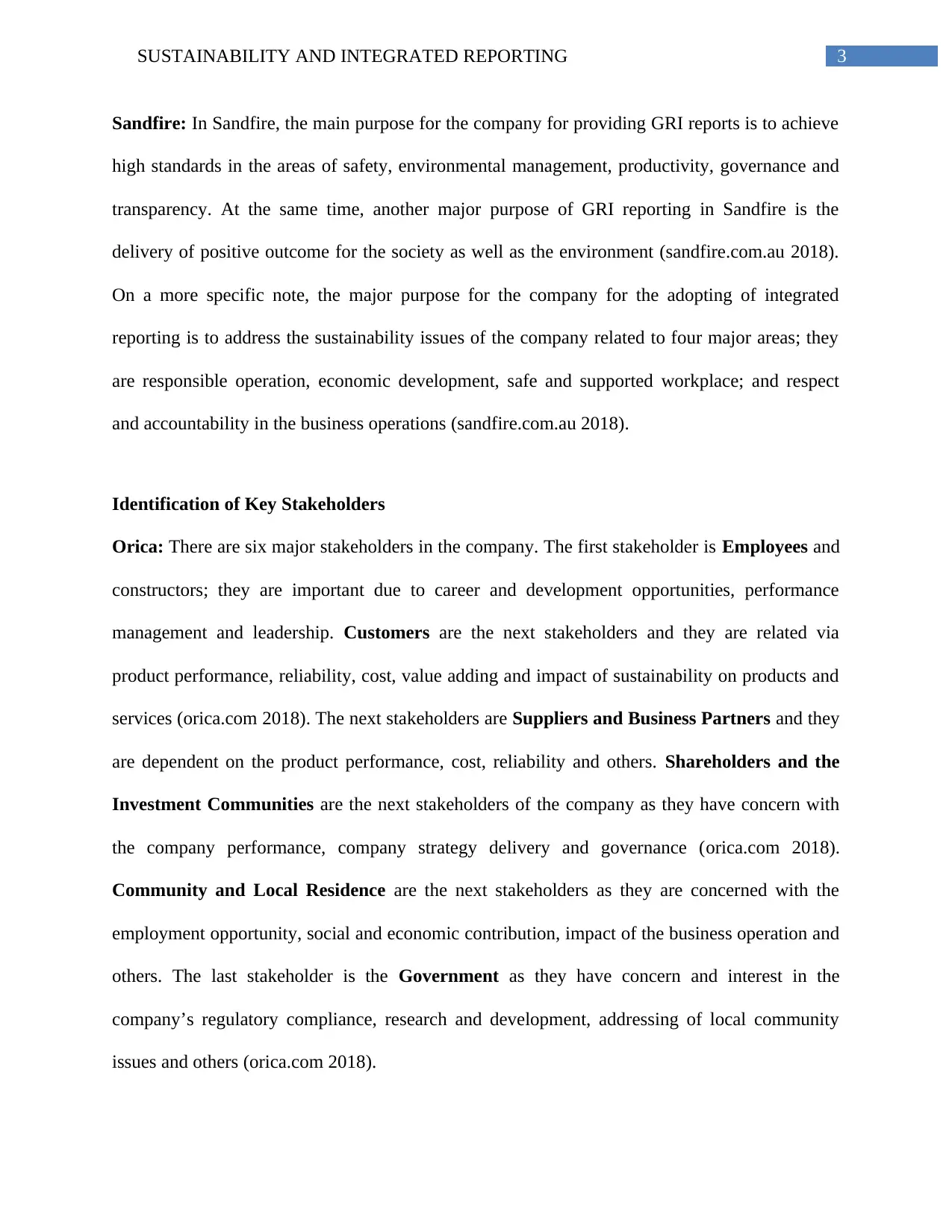
3SUSTAINABILITY AND INTEGRATED REPORTING
Sandfire: In Sandfire, the main purpose for the company for providing GRI reports is to achieve
high standards in the areas of safety, environmental management, productivity, governance and
transparency. At the same time, another major purpose of GRI reporting in Sandfire is the
delivery of positive outcome for the society as well as the environment (sandfire.com.au 2018).
On a more specific note, the major purpose for the company for the adopting of integrated
reporting is to address the sustainability issues of the company related to four major areas; they
are responsible operation, economic development, safe and supported workplace; and respect
and accountability in the business operations (sandfire.com.au 2018).
Identification of Key Stakeholders
Orica: There are six major stakeholders in the company. The first stakeholder is Employees and
constructors; they are important due to career and development opportunities, performance
management and leadership. Customers are the next stakeholders and they are related via
product performance, reliability, cost, value adding and impact of sustainability on products and
services (orica.com 2018). The next stakeholders are Suppliers and Business Partners and they
are dependent on the product performance, cost, reliability and others. Shareholders and the
Investment Communities are the next stakeholders of the company as they have concern with
the company performance, company strategy delivery and governance (orica.com 2018).
Community and Local Residence are the next stakeholders as they are concerned with the
employment opportunity, social and economic contribution, impact of the business operation and
others. The last stakeholder is the Government as they have concern and interest in the
company’s regulatory compliance, research and development, addressing of local community
issues and others (orica.com 2018).
Sandfire: In Sandfire, the main purpose for the company for providing GRI reports is to achieve
high standards in the areas of safety, environmental management, productivity, governance and
transparency. At the same time, another major purpose of GRI reporting in Sandfire is the
delivery of positive outcome for the society as well as the environment (sandfire.com.au 2018).
On a more specific note, the major purpose for the company for the adopting of integrated
reporting is to address the sustainability issues of the company related to four major areas; they
are responsible operation, economic development, safe and supported workplace; and respect
and accountability in the business operations (sandfire.com.au 2018).
Identification of Key Stakeholders
Orica: There are six major stakeholders in the company. The first stakeholder is Employees and
constructors; they are important due to career and development opportunities, performance
management and leadership. Customers are the next stakeholders and they are related via
product performance, reliability, cost, value adding and impact of sustainability on products and
services (orica.com 2018). The next stakeholders are Suppliers and Business Partners and they
are dependent on the product performance, cost, reliability and others. Shareholders and the
Investment Communities are the next stakeholders of the company as they have concern with
the company performance, company strategy delivery and governance (orica.com 2018).
Community and Local Residence are the next stakeholders as they are concerned with the
employment opportunity, social and economic contribution, impact of the business operation and
others. The last stakeholder is the Government as they have concern and interest in the
company’s regulatory compliance, research and development, addressing of local community
issues and others (orica.com 2018).
Paraphrase This Document
Need a fresh take? Get an instant paraphrase of this document with our AI Paraphraser
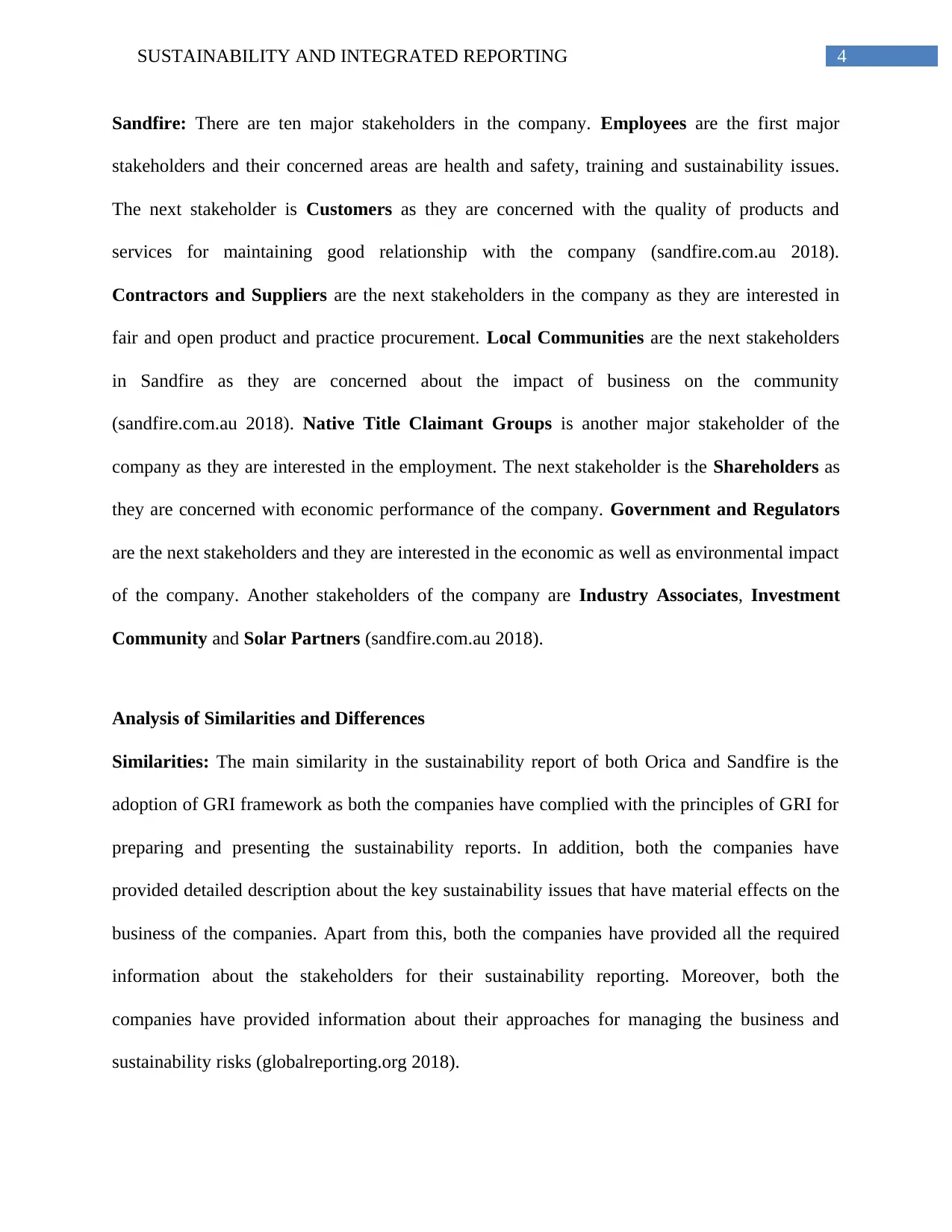
4SUSTAINABILITY AND INTEGRATED REPORTING
Sandfire: There are ten major stakeholders in the company. Employees are the first major
stakeholders and their concerned areas are health and safety, training and sustainability issues.
The next stakeholder is Customers as they are concerned with the quality of products and
services for maintaining good relationship with the company (sandfire.com.au 2018).
Contractors and Suppliers are the next stakeholders in the company as they are interested in
fair and open product and practice procurement. Local Communities are the next stakeholders
in Sandfire as they are concerned about the impact of business on the community
(sandfire.com.au 2018). Native Title Claimant Groups is another major stakeholder of the
company as they are interested in the employment. The next stakeholder is the Shareholders as
they are concerned with economic performance of the company. Government and Regulators
are the next stakeholders and they are interested in the economic as well as environmental impact
of the company. Another stakeholders of the company are Industry Associates, Investment
Community and Solar Partners (sandfire.com.au 2018).
Analysis of Similarities and Differences
Similarities: The main similarity in the sustainability report of both Orica and Sandfire is the
adoption of GRI framework as both the companies have complied with the principles of GRI for
preparing and presenting the sustainability reports. In addition, both the companies have
provided detailed description about the key sustainability issues that have material effects on the
business of the companies. Apart from this, both the companies have provided all the required
information about the stakeholders for their sustainability reporting. Moreover, both the
companies have provided information about their approaches for managing the business and
sustainability risks (globalreporting.org 2018).
Sandfire: There are ten major stakeholders in the company. Employees are the first major
stakeholders and their concerned areas are health and safety, training and sustainability issues.
The next stakeholder is Customers as they are concerned with the quality of products and
services for maintaining good relationship with the company (sandfire.com.au 2018).
Contractors and Suppliers are the next stakeholders in the company as they are interested in
fair and open product and practice procurement. Local Communities are the next stakeholders
in Sandfire as they are concerned about the impact of business on the community
(sandfire.com.au 2018). Native Title Claimant Groups is another major stakeholder of the
company as they are interested in the employment. The next stakeholder is the Shareholders as
they are concerned with economic performance of the company. Government and Regulators
are the next stakeholders and they are interested in the economic as well as environmental impact
of the company. Another stakeholders of the company are Industry Associates, Investment
Community and Solar Partners (sandfire.com.au 2018).
Analysis of Similarities and Differences
Similarities: The main similarity in the sustainability report of both Orica and Sandfire is the
adoption of GRI framework as both the companies have complied with the principles of GRI for
preparing and presenting the sustainability reports. In addition, both the companies have
provided detailed description about the key sustainability issues that have material effects on the
business of the companies. Apart from this, both the companies have provided all the required
information about the stakeholders for their sustainability reporting. Moreover, both the
companies have provided information about their approaches for managing the business and
sustainability risks (globalreporting.org 2018).
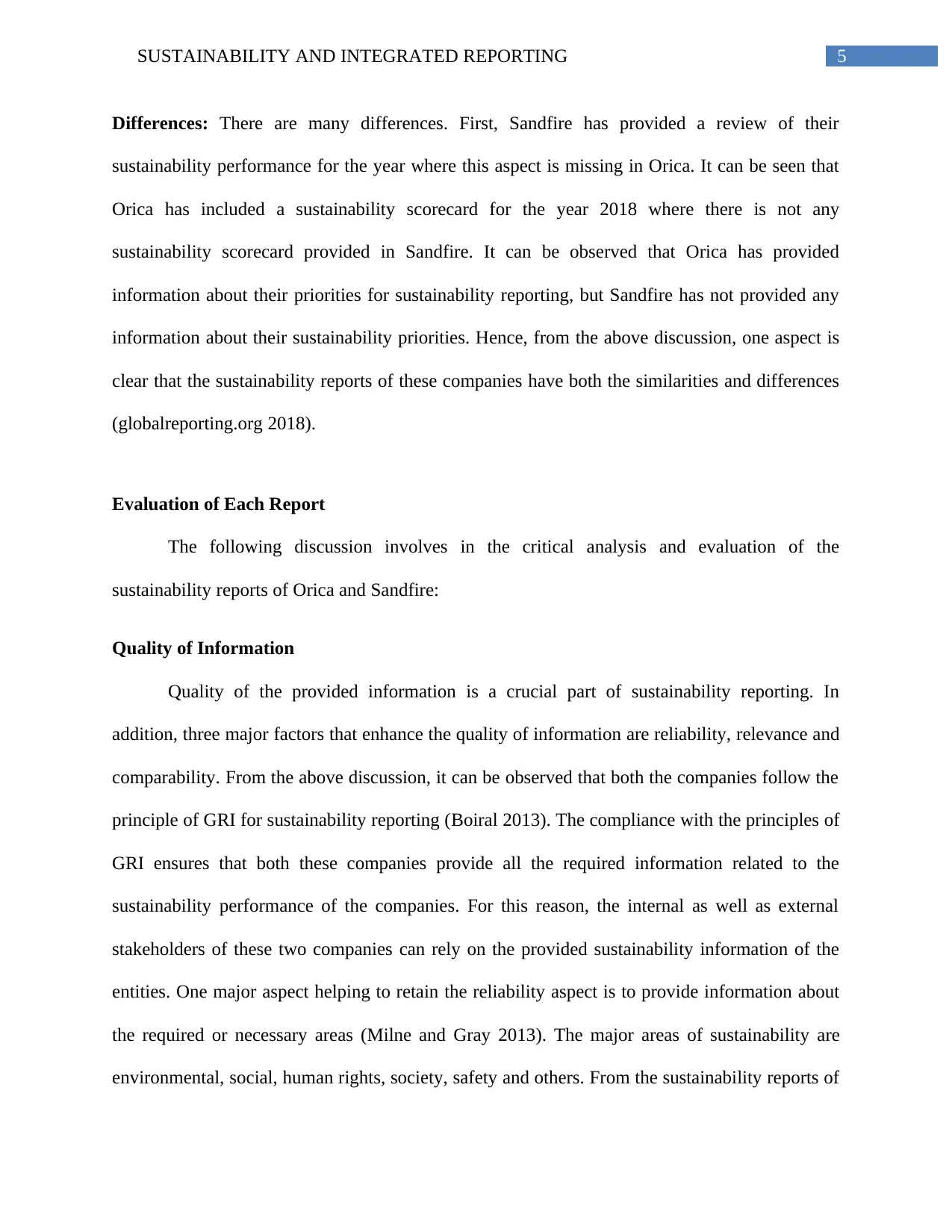
5SUSTAINABILITY AND INTEGRATED REPORTING
Differences: There are many differences. First, Sandfire has provided a review of their
sustainability performance for the year where this aspect is missing in Orica. It can be seen that
Orica has included a sustainability scorecard for the year 2018 where there is not any
sustainability scorecard provided in Sandfire. It can be observed that Orica has provided
information about their priorities for sustainability reporting, but Sandfire has not provided any
information about their sustainability priorities. Hence, from the above discussion, one aspect is
clear that the sustainability reports of these companies have both the similarities and differences
(globalreporting.org 2018).
Evaluation of Each Report
The following discussion involves in the critical analysis and evaluation of the
sustainability reports of Orica and Sandfire:
Quality of Information
Quality of the provided information is a crucial part of sustainability reporting. In
addition, three major factors that enhance the quality of information are reliability, relevance and
comparability. From the above discussion, it can be observed that both the companies follow the
principle of GRI for sustainability reporting (Boiral 2013). The compliance with the principles of
GRI ensures that both these companies provide all the required information related to the
sustainability performance of the companies. For this reason, the internal as well as external
stakeholders of these two companies can rely on the provided sustainability information of the
entities. One major aspect helping to retain the reliability aspect is to provide information about
the required or necessary areas (Milne and Gray 2013). The major areas of sustainability are
environmental, social, human rights, society, safety and others. From the sustainability reports of
Differences: There are many differences. First, Sandfire has provided a review of their
sustainability performance for the year where this aspect is missing in Orica. It can be seen that
Orica has included a sustainability scorecard for the year 2018 where there is not any
sustainability scorecard provided in Sandfire. It can be observed that Orica has provided
information about their priorities for sustainability reporting, but Sandfire has not provided any
information about their sustainability priorities. Hence, from the above discussion, one aspect is
clear that the sustainability reports of these companies have both the similarities and differences
(globalreporting.org 2018).
Evaluation of Each Report
The following discussion involves in the critical analysis and evaluation of the
sustainability reports of Orica and Sandfire:
Quality of Information
Quality of the provided information is a crucial part of sustainability reporting. In
addition, three major factors that enhance the quality of information are reliability, relevance and
comparability. From the above discussion, it can be observed that both the companies follow the
principle of GRI for sustainability reporting (Boiral 2013). The compliance with the principles of
GRI ensures that both these companies provide all the required information related to the
sustainability performance of the companies. For this reason, the internal as well as external
stakeholders of these two companies can rely on the provided sustainability information of the
entities. One major aspect helping to retain the reliability aspect is to provide information about
the required or necessary areas (Milne and Gray 2013). The major areas of sustainability are
environmental, social, human rights, society, safety and others. From the sustainability reports of
⊘ This is a preview!⊘
Do you want full access?
Subscribe today to unlock all pages.

Trusted by 1+ million students worldwide
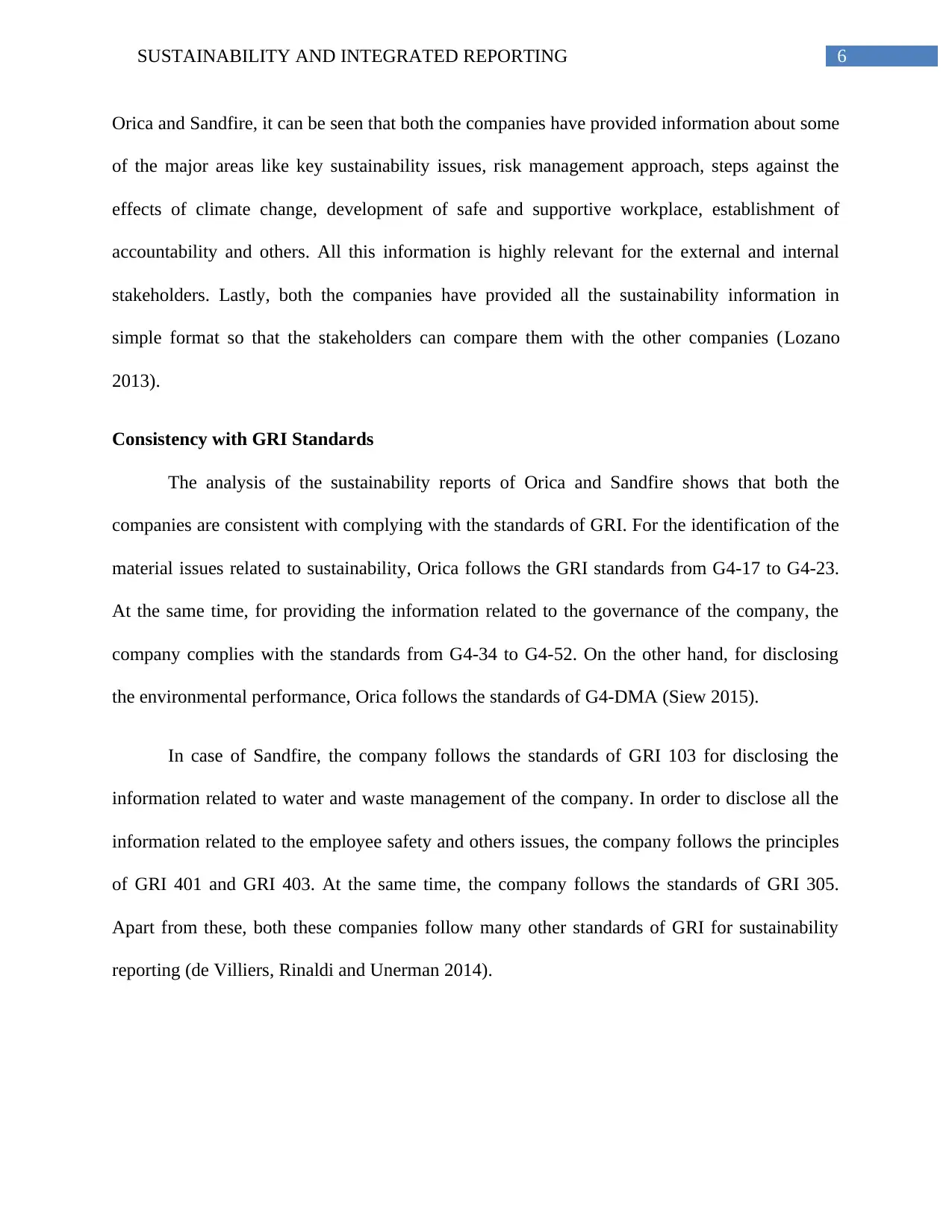
6SUSTAINABILITY AND INTEGRATED REPORTING
Orica and Sandfire, it can be seen that both the companies have provided information about some
of the major areas like key sustainability issues, risk management approach, steps against the
effects of climate change, development of safe and supportive workplace, establishment of
accountability and others. All this information is highly relevant for the external and internal
stakeholders. Lastly, both the companies have provided all the sustainability information in
simple format so that the stakeholders can compare them with the other companies (Lozano
2013).
Consistency with GRI Standards
The analysis of the sustainability reports of Orica and Sandfire shows that both the
companies are consistent with complying with the standards of GRI. For the identification of the
material issues related to sustainability, Orica follows the GRI standards from G4-17 to G4-23.
At the same time, for providing the information related to the governance of the company, the
company complies with the standards from G4-34 to G4-52. On the other hand, for disclosing
the environmental performance, Orica follows the standards of G4-DMA (Siew 2015).
In case of Sandfire, the company follows the standards of GRI 103 for disclosing the
information related to water and waste management of the company. In order to disclose all the
information related to the employee safety and others issues, the company follows the principles
of GRI 401 and GRI 403. At the same time, the company follows the standards of GRI 305.
Apart from these, both these companies follow many other standards of GRI for sustainability
reporting (de Villiers, Rinaldi and Unerman 2014).
Orica and Sandfire, it can be seen that both the companies have provided information about some
of the major areas like key sustainability issues, risk management approach, steps against the
effects of climate change, development of safe and supportive workplace, establishment of
accountability and others. All this information is highly relevant for the external and internal
stakeholders. Lastly, both the companies have provided all the sustainability information in
simple format so that the stakeholders can compare them with the other companies (Lozano
2013).
Consistency with GRI Standards
The analysis of the sustainability reports of Orica and Sandfire shows that both the
companies are consistent with complying with the standards of GRI. For the identification of the
material issues related to sustainability, Orica follows the GRI standards from G4-17 to G4-23.
At the same time, for providing the information related to the governance of the company, the
company complies with the standards from G4-34 to G4-52. On the other hand, for disclosing
the environmental performance, Orica follows the standards of G4-DMA (Siew 2015).
In case of Sandfire, the company follows the standards of GRI 103 for disclosing the
information related to water and waste management of the company. In order to disclose all the
information related to the employee safety and others issues, the company follows the principles
of GRI 401 and GRI 403. At the same time, the company follows the standards of GRI 305.
Apart from these, both these companies follow many other standards of GRI for sustainability
reporting (de Villiers, Rinaldi and Unerman 2014).
Paraphrase This Document
Need a fresh take? Get an instant paraphrase of this document with our AI Paraphraser
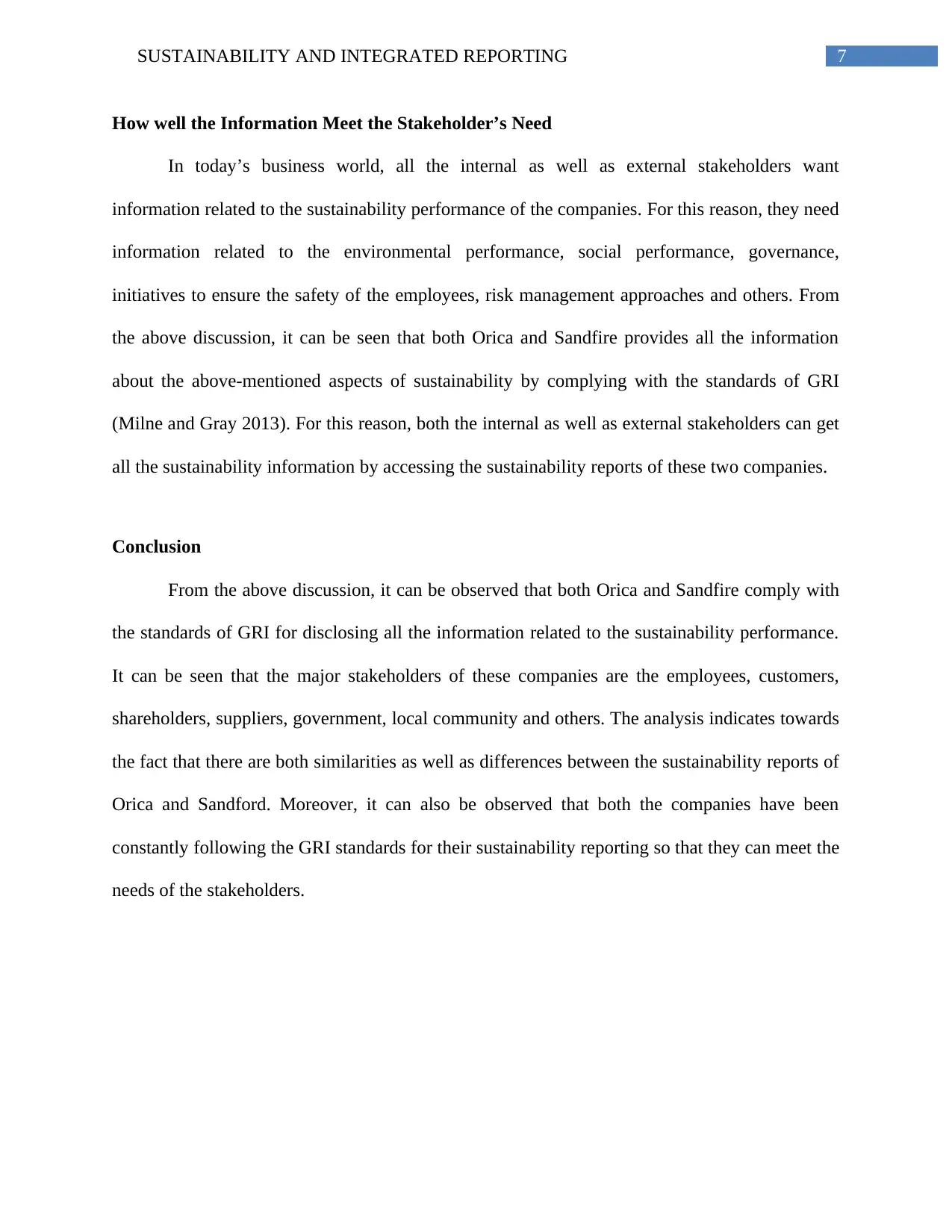
7SUSTAINABILITY AND INTEGRATED REPORTING
How well the Information Meet the Stakeholder’s Need
In today’s business world, all the internal as well as external stakeholders want
information related to the sustainability performance of the companies. For this reason, they need
information related to the environmental performance, social performance, governance,
initiatives to ensure the safety of the employees, risk management approaches and others. From
the above discussion, it can be seen that both Orica and Sandfire provides all the information
about the above-mentioned aspects of sustainability by complying with the standards of GRI
(Milne and Gray 2013). For this reason, both the internal as well as external stakeholders can get
all the sustainability information by accessing the sustainability reports of these two companies.
Conclusion
From the above discussion, it can be observed that both Orica and Sandfire comply with
the standards of GRI for disclosing all the information related to the sustainability performance.
It can be seen that the major stakeholders of these companies are the employees, customers,
shareholders, suppliers, government, local community and others. The analysis indicates towards
the fact that there are both similarities as well as differences between the sustainability reports of
Orica and Sandford. Moreover, it can also be observed that both the companies have been
constantly following the GRI standards for their sustainability reporting so that they can meet the
needs of the stakeholders.
How well the Information Meet the Stakeholder’s Need
In today’s business world, all the internal as well as external stakeholders want
information related to the sustainability performance of the companies. For this reason, they need
information related to the environmental performance, social performance, governance,
initiatives to ensure the safety of the employees, risk management approaches and others. From
the above discussion, it can be seen that both Orica and Sandfire provides all the information
about the above-mentioned aspects of sustainability by complying with the standards of GRI
(Milne and Gray 2013). For this reason, both the internal as well as external stakeholders can get
all the sustainability information by accessing the sustainability reports of these two companies.
Conclusion
From the above discussion, it can be observed that both Orica and Sandfire comply with
the standards of GRI for disclosing all the information related to the sustainability performance.
It can be seen that the major stakeholders of these companies are the employees, customers,
shareholders, suppliers, government, local community and others. The analysis indicates towards
the fact that there are both similarities as well as differences between the sustainability reports of
Orica and Sandford. Moreover, it can also be observed that both the companies have been
constantly following the GRI standards for their sustainability reporting so that they can meet the
needs of the stakeholders.
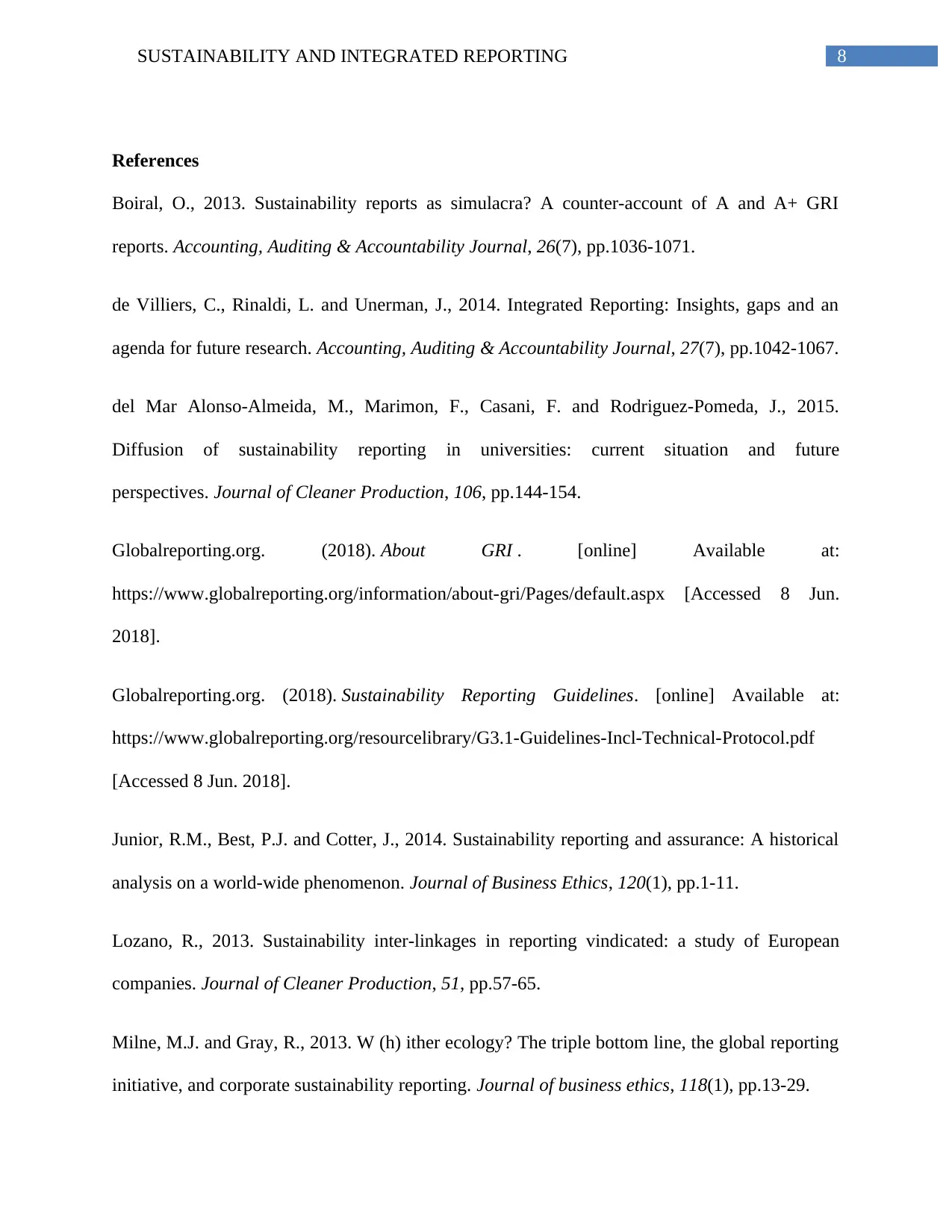
8SUSTAINABILITY AND INTEGRATED REPORTING
References
Boiral, O., 2013. Sustainability reports as simulacra? A counter-account of A and A+ GRI
reports. Accounting, Auditing & Accountability Journal, 26(7), pp.1036-1071.
de Villiers, C., Rinaldi, L. and Unerman, J., 2014. Integrated Reporting: Insights, gaps and an
agenda for future research. Accounting, Auditing & Accountability Journal, 27(7), pp.1042-1067.
del Mar Alonso-Almeida, M., Marimon, F., Casani, F. and Rodriguez-Pomeda, J., 2015.
Diffusion of sustainability reporting in universities: current situation and future
perspectives. Journal of Cleaner Production, 106, pp.144-154.
Globalreporting.org. (2018). About GRI . [online] Available at:
https://www.globalreporting.org/information/about-gri/Pages/default.aspx [Accessed 8 Jun.
2018].
Globalreporting.org. (2018). Sustainability Reporting Guidelines. [online] Available at:
https://www.globalreporting.org/resourcelibrary/G3.1-Guidelines-Incl-Technical-Protocol.pdf
[Accessed 8 Jun. 2018].
Junior, R.M., Best, P.J. and Cotter, J., 2014. Sustainability reporting and assurance: A historical
analysis on a world-wide phenomenon. Journal of Business Ethics, 120(1), pp.1-11.
Lozano, R., 2013. Sustainability inter-linkages in reporting vindicated: a study of European
companies. Journal of Cleaner Production, 51, pp.57-65.
Milne, M.J. and Gray, R., 2013. W (h) ither ecology? The triple bottom line, the global reporting
initiative, and corporate sustainability reporting. Journal of business ethics, 118(1), pp.13-29.
References
Boiral, O., 2013. Sustainability reports as simulacra? A counter-account of A and A+ GRI
reports. Accounting, Auditing & Accountability Journal, 26(7), pp.1036-1071.
de Villiers, C., Rinaldi, L. and Unerman, J., 2014. Integrated Reporting: Insights, gaps and an
agenda for future research. Accounting, Auditing & Accountability Journal, 27(7), pp.1042-1067.
del Mar Alonso-Almeida, M., Marimon, F., Casani, F. and Rodriguez-Pomeda, J., 2015.
Diffusion of sustainability reporting in universities: current situation and future
perspectives. Journal of Cleaner Production, 106, pp.144-154.
Globalreporting.org. (2018). About GRI . [online] Available at:
https://www.globalreporting.org/information/about-gri/Pages/default.aspx [Accessed 8 Jun.
2018].
Globalreporting.org. (2018). Sustainability Reporting Guidelines. [online] Available at:
https://www.globalreporting.org/resourcelibrary/G3.1-Guidelines-Incl-Technical-Protocol.pdf
[Accessed 8 Jun. 2018].
Junior, R.M., Best, P.J. and Cotter, J., 2014. Sustainability reporting and assurance: A historical
analysis on a world-wide phenomenon. Journal of Business Ethics, 120(1), pp.1-11.
Lozano, R., 2013. Sustainability inter-linkages in reporting vindicated: a study of European
companies. Journal of Cleaner Production, 51, pp.57-65.
Milne, M.J. and Gray, R., 2013. W (h) ither ecology? The triple bottom line, the global reporting
initiative, and corporate sustainability reporting. Journal of business ethics, 118(1), pp.13-29.
⊘ This is a preview!⊘
Do you want full access?
Subscribe today to unlock all pages.

Trusted by 1+ million students worldwide
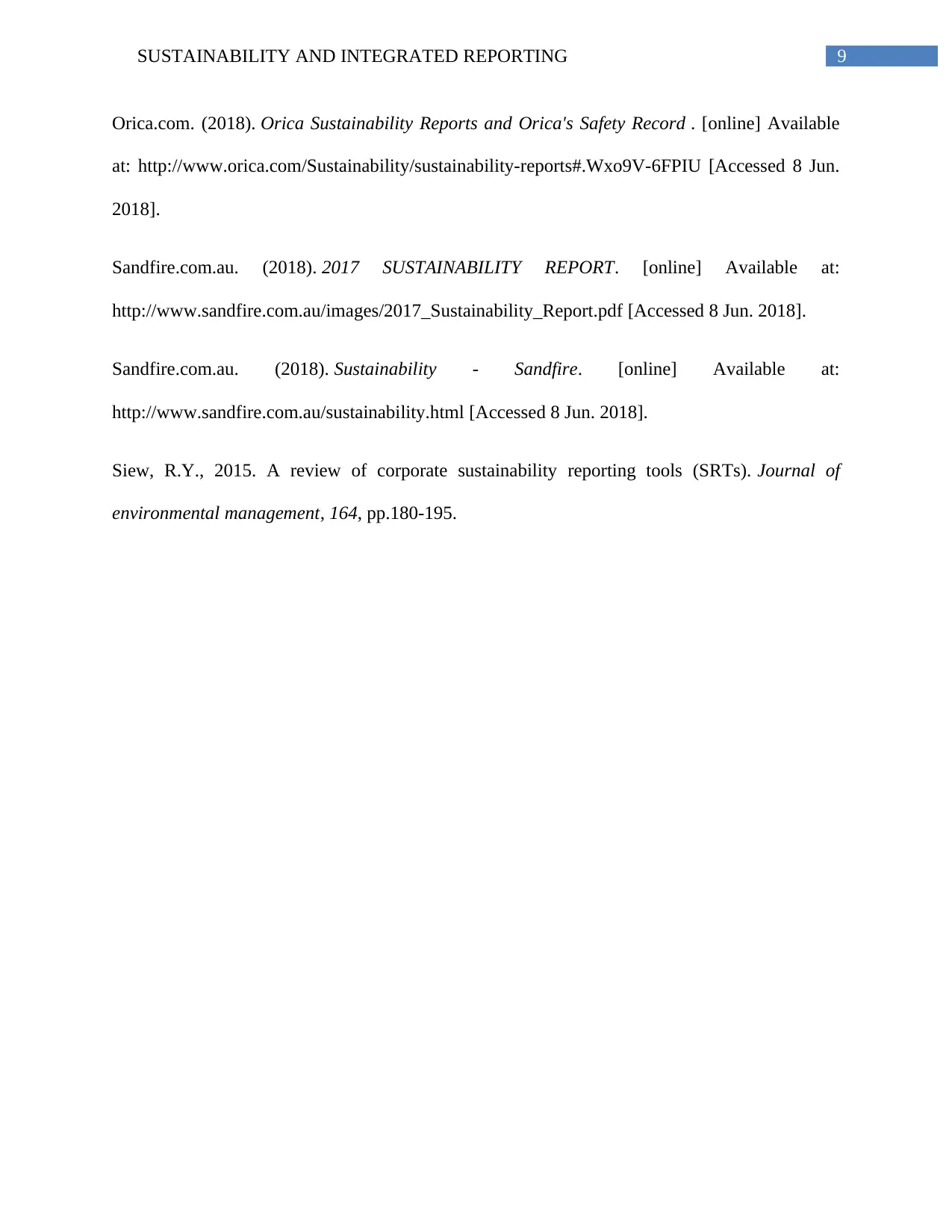
9SUSTAINABILITY AND INTEGRATED REPORTING
Orica.com. (2018). Orica Sustainability Reports and Orica's Safety Record . [online] Available
at: http://www.orica.com/Sustainability/sustainability-reports#.Wxo9V-6FPIU [Accessed 8 Jun.
2018].
Sandfire.com.au. (2018). 2017 SUSTAINABILITY REPORT. [online] Available at:
http://www.sandfire.com.au/images/2017_Sustainability_Report.pdf [Accessed 8 Jun. 2018].
Sandfire.com.au. (2018). Sustainability - Sandfire. [online] Available at:
http://www.sandfire.com.au/sustainability.html [Accessed 8 Jun. 2018].
Siew, R.Y., 2015. A review of corporate sustainability reporting tools (SRTs). Journal of
environmental management, 164, pp.180-195.
Orica.com. (2018). Orica Sustainability Reports and Orica's Safety Record . [online] Available
at: http://www.orica.com/Sustainability/sustainability-reports#.Wxo9V-6FPIU [Accessed 8 Jun.
2018].
Sandfire.com.au. (2018). 2017 SUSTAINABILITY REPORT. [online] Available at:
http://www.sandfire.com.au/images/2017_Sustainability_Report.pdf [Accessed 8 Jun. 2018].
Sandfire.com.au. (2018). Sustainability - Sandfire. [online] Available at:
http://www.sandfire.com.au/sustainability.html [Accessed 8 Jun. 2018].
Siew, R.Y., 2015. A review of corporate sustainability reporting tools (SRTs). Journal of
environmental management, 164, pp.180-195.
1 out of 10
Related Documents
Your All-in-One AI-Powered Toolkit for Academic Success.
+13062052269
info@desklib.com
Available 24*7 on WhatsApp / Email
![[object Object]](/_next/static/media/star-bottom.7253800d.svg)
Unlock your academic potential
Copyright © 2020–2025 A2Z Services. All Rights Reserved. Developed and managed by ZUCOL.




